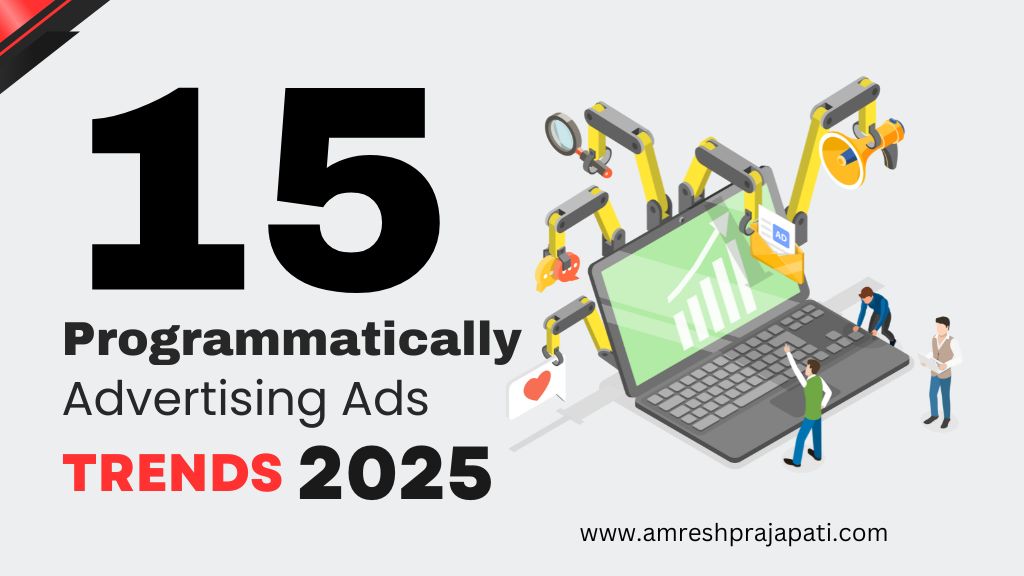The landscape of programmatic advertising is rapidly evolving, fueled by technological advancements and shifting consumer behaviours. As we edge closer to 2025, staying ahead of these changes is crucial for leveraging the full potential of programmatic ads. This article explores the top ten trends that will define the future of programmatic marketing, providing insights and examples to help advertisers adapt and thrive in this dynamic environment.
1. Increased Use of AI and Machine Learning
What is Programmatic advertising? It has always been about precision and efficiency, and leading this transformation in 2025 will be Artificial Intelligence (AI) and Machine Learning (ML). These technologies analyze vast amounts of data, predicting user behaviour with unmatched accuracy, and ensuring that ads reach the right audience at the optimal time. The level of precision that AI and ML bring to programmatic marketing was unimaginable just a few years ago but is now becoming standard practice.
Personalization through Predictive Analytics
Machine learning algorithms continuously learn from user interactions, refining ad strategies in real-time. Predictive analytics, a sophisticated branch of ML, anticipates future user behaviours, enabling hyper-personalized ad experiences. This heightened level of personalization fosters deeper consumer connections and significantly boosts conversion rates, making it an indispensable element of any programmatic advertising strategy.
2. Growth of Connected TV (CTV) Advertising
Connected TV (CTV) is rapidly becoming a dominant force in the advertising world, combining the broad reach of traditional television with the precision targeting capabilities of digital advertising. With a growing number of consumers abandoning cable for streaming services, CTV offers advertisers an unprecedented opportunity to deliver tailored content to highly engaged audiences.
Advantages for Advertisers
CTV’s precise targeting capabilities allow advertisers to deliver personalized ads based on detailed viewer data, track engagement metrics in real-time, and adjust campaigns instantly. This level of control and insight, previously unattainable in traditional TV advertising, makes CTV an essential component of any comprehensive programmatic digital advertising strategy.
3. Privacy-First Advertising
The rise of stringent privacy regulations such as the General Data Protection Regulation (GDPR) and the California Consumer Privacy Act (CCPA) has significantly reshaped the advertising landscape. These regulations prioritize user consent and data protection, compelling advertisers to rethink their strategies to remain compliant and effective.
Ensuring Compliance and Building Trust
To navigate this new regulatory environment, advertisers are adopting privacy-centric approaches, such as contextual targeting, which aligns ads with the content being consumed rather than relying on personal data. This approach not only ensures compliance but also builds trust with consumers who are increasingly valuing their privacy. As a result, respecting user privacy has become a fundamental aspect of programmatic display advertising.
4. Enhanced Data Analytics
In the age of data, Big Data analytics plays a crucial role in shaping modern advertising strategies. By analyzing patterns and trends, advertisers gain deep insights into consumer behaviour, enabling them to craft more effective and targeted campaigns.
Predictive Analytics for Campaign Success
Predictive analytics, which utilizes historical data to anticipate future trends, is becoming increasingly important in programmatic advertising. This capability allows advertisers to predict user needs and preferences, staying ahead of the curve and delivering timely, relevant ads. The proactive nature of predictive analytics enhances the effectiveness of programmatic display and video advertising, driving better campaign outcomes.
5. Expansion of Programmatic Audio Advertising
With the rising popularity of audio streaming platforms like Spotify and the growing consumption of podcasts, programmatic audio advertising is emerging as a powerful channel for reaching audiences in new, non-intrusive ways.
The Efficacy of Audio Ads
Audio ads offer a unique opportunity to engage listeners during moments when visual ads are impractical. Their personal and intimate nature fosters a deeper connection with the audience. Programmatic technology enhances this by delivering personalized audio ads that resonate with individual preferences, showcasing the versatility and potential of programmatic advertising platforms.
6. Augmented Reality (AR) Integration
Augmented Reality (AR) is transforming advertising by delivering highly engaging and interactive experiences. AR ads allow users to interact with products and services in a way that static ads cannot, creating a novel and memorable experience.
Engaging Consumers with Immersive Experiences
Through AR, consumers can visualize products in their environment, try on virtual clothing, or interact with 3D models. This immersive engagement significantly enhances the user experience and drives higher conversion rates, offering a glimpse into the future of programmatic advertising.
7. Emergence of Programmatic Out-of-Home (OOH) Advertising
Programmatic Out-of-Home (OOH) advertising is transforming traditional outdoor advertising by merging the benefits of digital advertising with physical spaces. Digital billboards and screens can now display targeted ads based on real-time data, such as location, weather, and time of day.
Benefits of Programmatic OOH
The flexibility and precision of programmatic OOH allow advertisers to adjust their messages on the fly, target specific demographics, and measure campaign effectiveness with greater accuracy. This evolution makes OOH advertising more dynamic and impactful, underscoring the importance of understanding programmatic advertising in this new context.
8. The Evolution of Real-Time Bidding (RTB): Optimizing Ad Spend
Real-time bidding (RTB) technology has advanced significantly, enabling faster and more accurate bidding processes. These improvements ensure that ads are displayed to the right users at the right time, optimizing both ad spend and performance.
Enhancing Ad Efficiency with RTB
By leveraging the latest RTB technology, advertisers can minimize waste, increase return on investment (ROI), and improve overall campaign efficiency. The ability to bid in real-time based on user data and contextual factors enhances the effectiveness of programmatic advertising, making it a critical tool in any marketer’s arsenal.
9. Cross-Device Targeting
In today’s multi-device world, users frequently switch between devices throughout the day. Cross-device targeting ensures that ads follow users across their devices, providing a consistent and cohesive experience, which is essential for successful programmatic advertising.
Techniques for Effective Cross-Device Campaigns
Effective cross-device targeting involves techniques like device mapping and user identification. By understanding the user’s journey across multiple devices, advertisers can deliver relevant and unified messages that drive engagement and conversions. This capability is a key feature of the best programmatic advertising platforms.
10. Sustainability in Programmatic Advertising
As consumers become more environmentally conscious, sustainability is becoming a key consideration in advertising strategies. Eco-friendly practices, such as reducing carbon footprints and using sustainable materials, are gaining traction in the programmatic advertising space.
Impact of Sustainability on Consumer Perception
Consumers are increasingly supportive of brands that demonstrate a commitment to sustainability. By adopting eco-friendly advertising practices, advertisers can enhance their brand image, build trust, and attract environmentally-conscious consumers. This trend underscores the growing importance of integrating sustainability into programmatic advertising strategies.
11. Evolution of Programmatic Direct
Programmatic Direct, where advertisers buy guaranteed ad impressions directly from publishers, will continue to evolve in 2025. This method offers more control and transparency compared to open exchanges, and as a result, more advertisers will gravitate toward it. Expect to see more premium publishers offering Programmatic Direct deals, leading to higher-quality inventory.
12. 5G on Programmatic Advertising
The rollout of 5G technology will have a profound impact on programmatic advertising in 2025. With faster internet speeds and lower latency, advertisers will be able to deliver richer, more interactive ads to mobile devices. This will open up new possibilities for real-time bidding, augmented reality (AR) ads, and other advanced formats that require high bandwidth.
13. Shift Toward Ethical Advertising
Ethical advertising will gain prominence in 2025 as consumers demand more transparency and responsibility from brands. Programmatic campaigns will need to adhere to higher ethical standards, avoiding misleading or manipulative tactics. Brands that prioritize honesty, inclusivity, and social responsibility in their advertising will not only build trust with consumers but also achieve better long-term success.
14. Increased Focus on Creative Optimization
Creative optimization will become a key focus in 2025 as advertisers strive to create more engaging and effective ads. Dynamic Creative Optimization (DCO) will allow brands to automatically tailor their ads based on user data, ensuring that each impression is as relevant as possible. This trend will lead to more personalized and impactful ad experiences for consumers.
15. Growth of Video Advertising
Video continues to be one of the most engaging forms of content, and its role in programmatic advertising will only grow in 2025. With the proliferation of short-form videos on platforms like TikTok and Instagram Reels, advertisers will need to adapt their strategies to include more dynamic, visually compelling content. Expect to see more personalized video ads driven by AI, tailored to individual viewer preferences.
Final Thoughts
The programmatic advertising landscape is poised for significant changes by 2025. From the advancements in AI and CTV to the rise of privacy-centric and sustainable practices, these trends will shape how advertisers connect with audiences and optimize their strategies.
Adapting to these trends is crucial for staying relevant and effective in the ever-evolving digital marketing environment. By embracing innovation and remaining adaptable, advertisers can ensure their campaigns remain impactful and resonate with their target audiences in 2025 and beyond.
The future of programmatic advertising is bright and full of opportunities. By staying informed and adaptable, advertisers can harness the power of these trends to drive engagement, enhance brand loyalty, and achieve their marketing goals. With technological advancements continuing to progress, the strategies and tools available to advertisers will likewise evolve, ensuring that programmatic advertising remains at the forefront of digital marketing innovation.
Read more Top Profitable Business Ideas Set to Dominate 2025
Frequently Asked Questions
1. What is programmatic advertising, and why is it important in 2025?
Programmatic advertising refers to the automated buying and selling of digital ad space using advanced algorithms and real-time data. In 2025, it’s more important than ever because it allows advertisers to reach highly targeted audiences efficiently, optimize campaigns in real-time, and deliver personalized ads that drive better results.
2. How will AI and machine learning impact programmatic advertising in 2025?
AI and machine learning will significantly enhance programmatic advertising by providing more accurate audience targeting, real-time campaign optimization, and predictive analytics. These technologies will enable advertisers to anticipate consumer behavior, adjust strategies on the fly, and maximize the return on their advertising investments.
3. What role does privacy-first advertising play in the future of programmatic advertising?
As privacy concerns grow and regulations tighten, privacy-first advertising will become a critical focus in 2025. Advertisers will need to prioritize consumer consent, use first-party data, and rely on contextual targeting to reach audiences while complying with privacy laws, ensuring trust and transparency in their campaigns.




